Dozens of curious Portlanders visited bike-culture hub Velo Cult Wednesday night to pore over a series of ideas for how to transform our city in the way the Dutch people decided to start reshaping theirs forty years ago.
“Though we remain America’s best city for bicycling, Portland has stagnated something fierce at a time when many other cities are recognizing the value of bike-friendliness,” event contributor Brian Davis wrote yesterday in a preview for PortlandTransport.com. That perspective captured the attitude of many who attended.
“They’re working on the Central City Plan; they’re working on the Comp Plan,” said Arnoud Van Sisseren, a Portland Bureau of Transportation volunteer and a Dutch native himself. “If we have that vision, it should translate in all the plans. … I’m at PBOT; I see what’s happening. It’s not enough. It’s not enough.”
Others disagreed with some of the ideas put forward. Ethan Jewett, who lives near Ainsworth Street and gets around largely by bike, called a proposal to run a two-way cycle track and walkway down the middle of Ainsworth’s grassy median “hooey.”
“There’s a neighborhood greenway a block from there,” Jewett pointed out.
Jewett was one of many, though, who liked the sketch of a “bike highway” running along the hillside above Interstate 84.
“Cars get highways,” said Karla Kingsley, a transportation analyst for Kittelson and Associates who often gets around by bike. “I should, too.”
Here are the six visualizations shared last night. (NOTE: Click each of the “after” images for a link to the (very large) PDFs that were on display at the event last night. Each one includes a close-up of design details, a list of “What’s stopping us,” and examples of specific Portland locations where the treatment might work.)
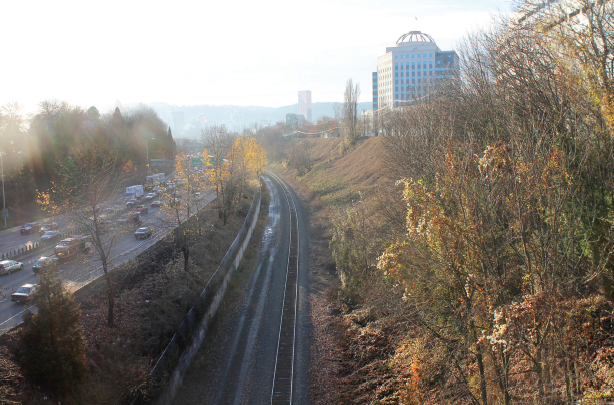

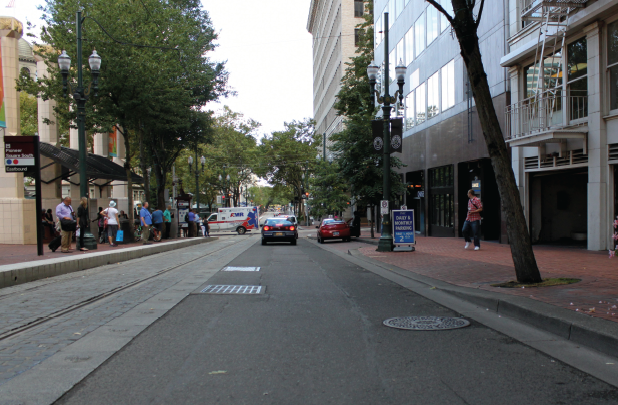
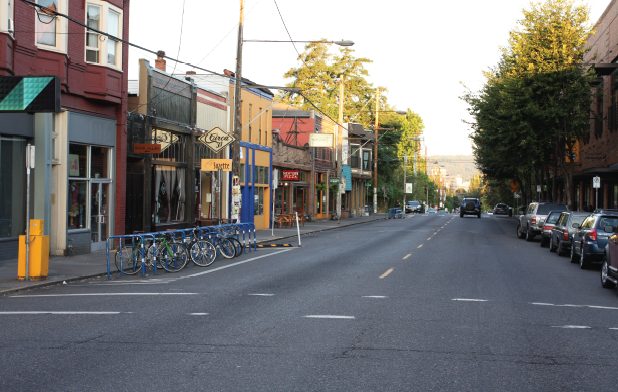
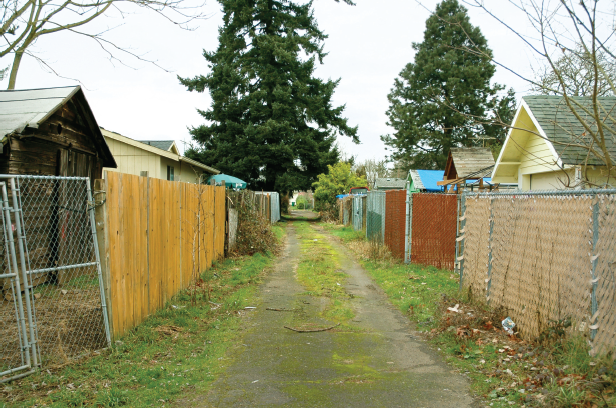
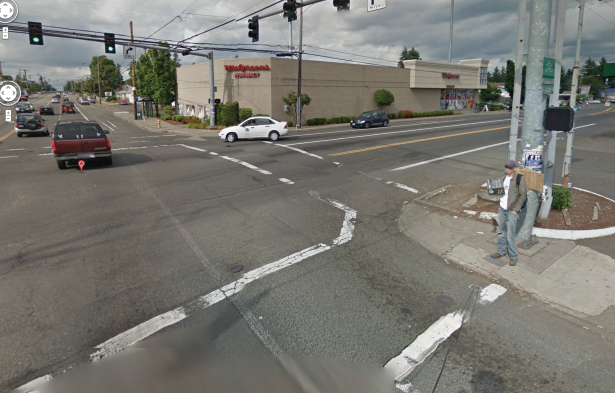
The event was organized by Portland’s new chapter of Young Professionals in Transportation, a new group that includes people with an impressive variety of backgrounds: nonprofits, for-profits, schools and government. (The leaders include Jesse Boudart and Anais Malinge of Kittelson and Associates, Heather McCarey of the new Washington Park TMA, Evan Corey and Brie Becker of Nelson\Nygaard, Jeff Owen of TriMet and Adam Moore of Portland State University.) The group, which formed in April, seems to be full of energy and interesting ideas; you can follow them on Twitter or LinkedIn.
Jonathan and I both attended this event and we’re excited to be seeing a debate emerge locally about what exactly the obstacles are to making changes like these in Portland. Stay tuned for more — we’re hoping to host a fascinating, well-informed exchange that emerged between a city staffer who attended and a couple of the event organizers.


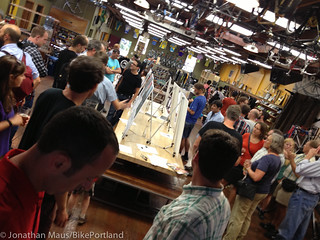

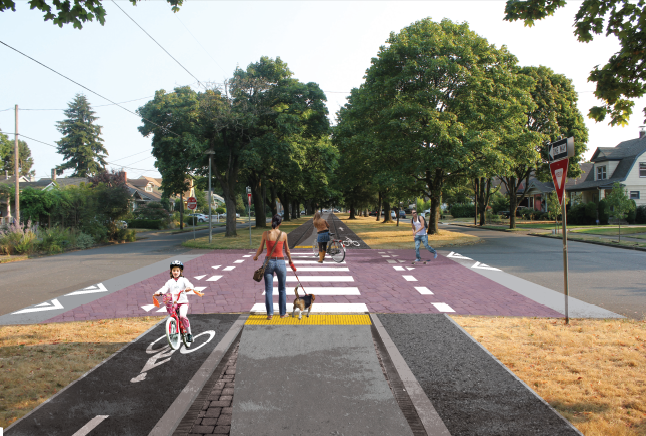
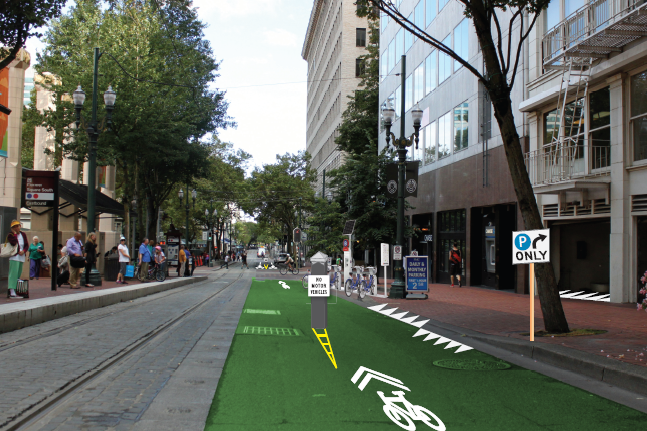
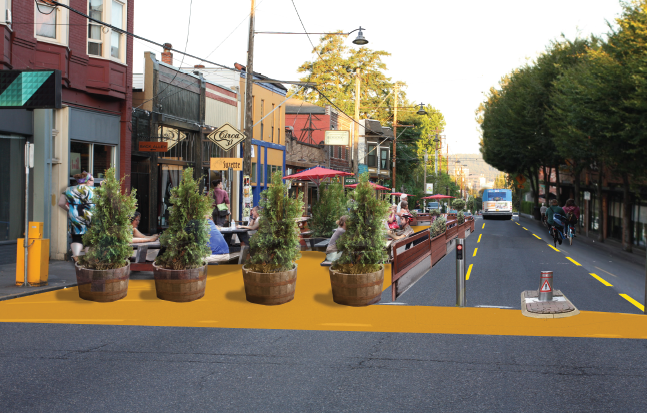
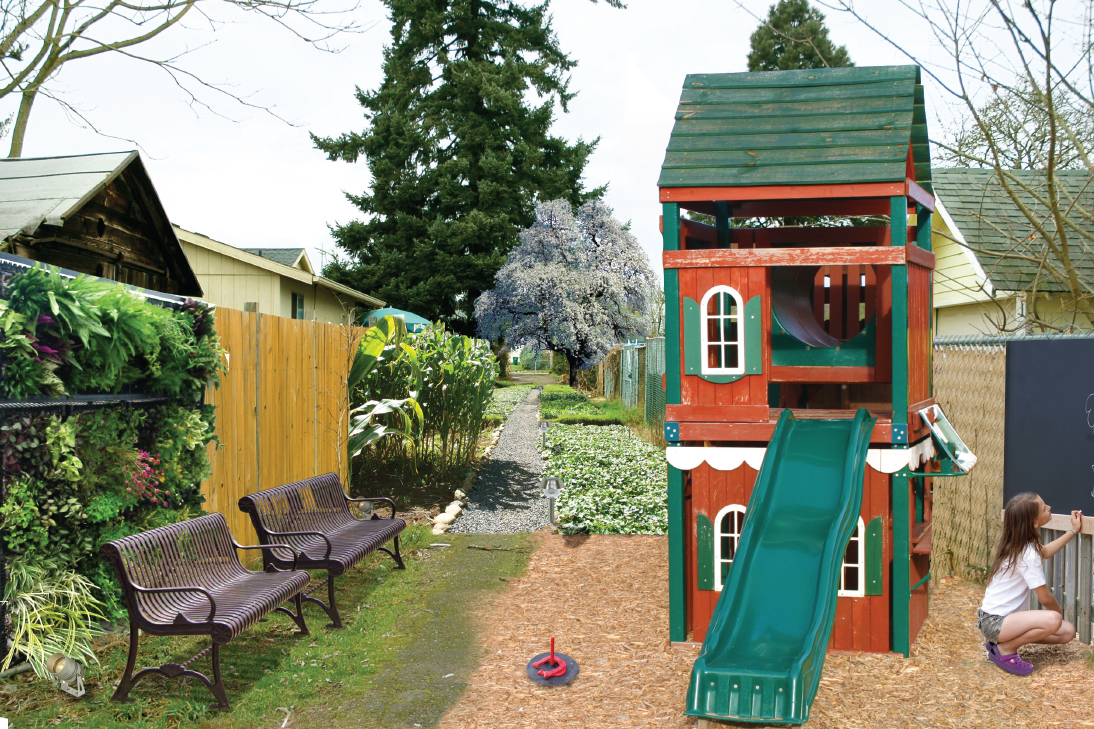
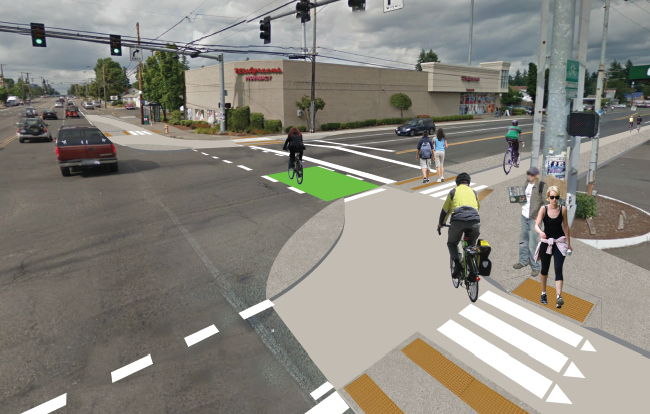

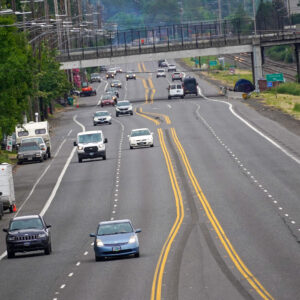
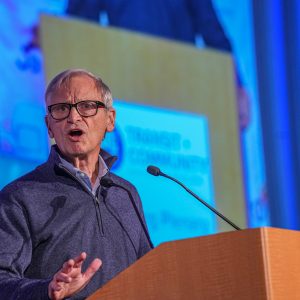
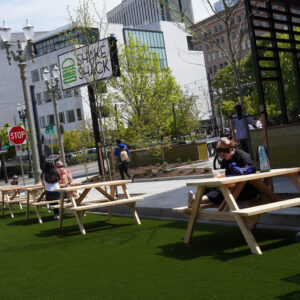
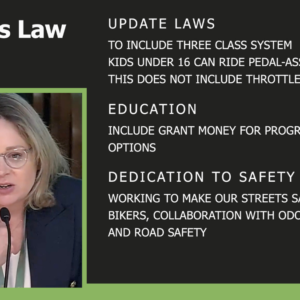
Thanks for reading.
BikePortland has served this community with independent community journalism since 2005. We rely on subscriptions from readers like you to survive. Your financial support is vital in keeping this valuable resource alive and well.
Please subscribe today to strengthen and expand our work.
Lots of potential! Let’s do it. We might be limited to a few pilot projects, but do them with timelines. Set dates for follow up reviews and if they are working, expand immediately. I mean, have expansion plans ready from the beginning of the pilots. Leave allowances for improvements so that we can learn from the pilot projects. The worst thing is to have a great pilot that gets no follow up.
What greenway is a block from Ainsworth? A park is not a greenway, and a greenway isn’t necessarily a bike hwy. There needs to be more bike highways. The little bike lanes are too small to pass people without pissing of drivers at places like Williams and Vancouver.
I could not disagree more with Ethan Jewett, and I say that as a personal friend of his (hi Ethan!). Seriously, the fact that there is a neighborhood greenway a few blocks away is not a reason to essentially advocate for no bicycling on streets like Ainsworth. There’s also a larger, and more appropriate street for people to drive on a few blocks away (Killingsworth)… So why don’t we encourage folks to drive there instead of Ainsworth?
People should have equitable access to Portland’s streets whether they are in a car or on a bike — and we should make context-based decisions on some streets where driving is the preferred mode and other streets where bicycling is the preferred mode, and still other streets where both can mix well together.
Ainsworth has plenty of room to make a better bikeway. We only lack imagination and the will to make it happen.
I see the draw of Ainsworth’s open space running right down the center. At the same time, I don’t have any reason to go to that stretch of Ainsworth. Killingsworth, on the other hand…that’s a street with destinations on it, a street that should function better for everyone. So: not saying a path on Ainsworth shouldn’t happen. I’m just pointing out that we’ve got LOTS of parallel routes in this city but very few comfortable routes on the streets that matter (Burnside, MLK, Powell, Killingsworth, 82nd, Broadway…).
If you look at the bike lane drop off and connections, focusing on a protected bike lane or cycle-track on Killingsworth makes MUCH more sense than a center lane down the green strip on Ainsworth. First, initially it would cost less. It also would connect the bike lanes up from NE 42nd to the Community College and Interstate directly. Killingsworth also has retail destinations that Ainsworth does not have. It is also a regional Active Transportation Corridor in Metro’s plan update I believe that is being worked on right now, where Ainsworth is not.
Plus, this city has small blocks (20 per Mile) which means there is a LOT of impervious surface compared to other cities with as little as 10 block per mile. Hence, removing green space down the center of Ainsworth at a cost of a million $ per mile does not make sense since Holman is only a few blocks away.
If we want to talk about an example project of a center cycle-track, Reed College Road as part of the 20’s bikeway would be the most logical since there is not another north-south bikeway there, would connect Reed College to the Springwater, and according to the Eastmoreland Neighborhood Association Newsfeed, they want to city to look into this alignment for “the 20’s” bikeway anyway.
I frequently ride on Ainsworth (especially eastbound) because it has beautiful pavement. I would rather see (and it’s certainly more affordable) an improved surface on Holman than a complicated separate bike/ped facility on Ainsworth (pretty as it is). Big capital projects are sorely needed, I just don’t think that is a worthy one.
I regularly commute to work along Ainsworth; sure there is a neighborhood greenway just north, but if you need to get somewhere, it is the last way to go. Riding a loaded cargo bike, I prefer to keep my momentum and not stop every other block. Add in the jogs to most of the neighborhood routes (as the direct routes have been kept for auto use) and it takes forever. I need to get all the way to St Johns, hence need a good crossing of MLK, I-5, and Interstate. Killingsworth would be great, but the political capital needed to pull that off makes Barber look easy. Much easier to pull the parking off Ainsworth (most have driveways and the sidestreets have plenty of room) and put in the lanes or (my favorite) put cycletracks in the parkway.
+100 for this approach to Ainsworth, which I similarly use regularly to jet from Concordia all the way to Willamette and beyond — downtown, the West Hills, Sauvie Island, etc.
When will planners realize that the same features that appeal to cars also appeal to cyclists — dedicated through infrastructure with good pavement and traffic signals!
And the shame with Ainsworth is that it’s mostly already done! The beauty, the trees, the traffic signals, the connectivity, the proximity to Killingsworth and Alberta — sunk money has already been spent to create all of it. *Just* remove the parking (impossible, I know, but one can dream), lay down some paint, and bingo — world class cycling infrastructure with minimal impact on motorists with minimal $$.
I know there are “greenways” (read: neglected, pothole-divot-and-seam-laden sharrowed afterthoughts with strange ambiguous cycle crossings that motorists ignore) nearby on Holman and Going, but WHY would I ever ride these??
Seems like a major issue with the People Places concept is that it’s a public endorsement of and investment in certain private enterprises. How do those businesses get selected for this investment, and do they have any financial contribution to or equity in the improvements?
The City of Portland is already endorsing public spaces via their ‘Street Seats’ program, where businesses pay for additional seats in the public right-of-way.
People Places is essentially a scaled up version of ‘Street Seats’ on 34th and Belmont. Instead of increasing a restaurant’s seating by one parking spot, each restaurant on the 34th block could get ~40% more seating based on their existing size. I don’t know their financials or kitchen constraints, but 40% more seating per day could yield a good return on investment.
The city is not “endorsing public spaces,” it is privatizing public spaces, contrary to best practices summarized by UCLA’s guidelines for these kinds of programs and contrary to what San Francisco and New York City have done. In those cities, the spaces carved out of the ROW for seating are truly public spaces not based on ability to pay. PBOT, in contrast, is selling off the commons.
A big thanks to everyone who came out last night.
A note about the Parkway Path design: the image shows SE 72nd, which is significantly wider than Ainsworth. While I think 72nd and the Reed College Parkway could support a center-running path, Ainsworth and Omaha are probably too skinny to have a path in the center. On those streets, cycle tracks running on the outside edge of the parkway might be possible
Thanks, Nick. I’ve changed that image’s title tag to refer to 72nd instead.
Yeah, Ainsworth would have to have the facilities on each side of the median, primarily due to the location of the trees: https://www.google.com/maps?ll=45.566291,-122.635339&spn=0.001549,0.003484&t=m&dg=opt&z=19&layer=c&cbll=45.566291,-122.635339&panoid=gc_nB4jGWani6q2q4pwg1Q&cbp=12,74.72,,0,6.37
And to I missed the correction and was gunna post that that would be awesome on SE 72nd.
I always think Ainsworth would be a perfect bikeway if it weren’t so awful to ride down it, next to parked cars, while other cars want to zip by. And lower vehicle traffic on Ainsworth seems like it would only improve the feel of the neighborhood for residents. I get why folks there wouldn’t want to give up their grassy blocks to more traffic, though… so why not limit Ainsworth to local traffic only with a few bollards every few blocks?
But, seriously, I almost cried at the after pic of the carfree downtown street with the tracks and bikeway. This city totally blew it when it didn’t include good bike facilities on the transit mall.
I think bike facilities on the transit mall are still doable when PBOT gets around to revisiting downtown bike access. And the Sullivan’s Gulch trail is already in planning, of course. The other renderings are pretty.
Sullivan’s Gulch is completely planned to the initial level….and shelved collecting dust in PBOT’s cyberspace vault. Until the railroad is willing to sell or allow use of its portion (69%) of the ROW needed that it owns, most of the trail is going no where.
The eastern end (Hancock to I 205 MUP) is a $1.7 Million connection that PBOT has already applied for funding for. There are another few connections that can be built without railroad approval, but no trail without a RR buy in. We have to talk to congress….
We can improve Ainsworth now at minimal expense: slow speed limits, narrow the motorvehicle lane, eliminate free vehicle storage, and splash some bike-specific paint on the road.
“eliminate free vehicle storage”
That would be the hard part. People like free parking at the curb in front of their residence. The houses on Ainsworth all have an alleyway in the back, so technically there is plenty of auto access even if curbside parking is removed, if parking were added to the alleys instead. But would the neighbors go for it?
The grassy median is almost 30 feet wide, so there is room to add space for bike lanes with a buffer, or cycletracks, on each side, while keeping the trees and a 10-foot wide median, and keeping the parking. The parking could even be moved to the middle (in the edges of the existing median) with the bike lanes on the right side, if that makes PBOT happier. Perhaps the parking area could have a permeable surface, like “brick” pavers or gravel, to reduce run-off and maintains something of the current look of the street.
I have never been in city where the residents feel like they have such a right to free parking on city streets. Until Portlanders get over this, we will never be able to properly fund our local transportation system.
It would be really easy to make Yamhill-Morrison a bikeway couplet where autos only had one-block access and then had to turn off. It could be done right now with planters, signs and paint. There would have to be a little parking removal and a tricky round the block maneuver to connect up safely with the Morrison Bridge MUP, but it could still go all the way to the Stadium and hook directly up to SW 20th which is a north-south greenway in the 2030 bike master plan.
All we would need is a business sector buy-in and PBOT could do this VERY fast with very little investment.
On the alleys… I actually don’t think making them carfree is the way to go. Lots of folks have garages that open up onto the alleys; this moves the curb cut to the back from the front of the house, preserving the sidewalk in the front of the house as an unmarred pedestrian zone.
The alleys should be beautified, sure; planted, yes; greenscaped so they have “permeable paving” that is passable for all vehicles, yes — but they should function as a woonerf, as shared bike/ped/auto space where the pedestrian mode dictates the speed and character of movement.
I actually just wrote a piece for Concordia News on this topic… it seems the alleys in our city are mostly neglected, and could definitely use some love. Closing them to cars, however, will have the detrimental effect of causing people to move auto access to the front, with more curb cuts, cars parked blocking the sidewalk, less on-street parking for visitors, etc, without a huge improvement for the alleys — for the most part, the alleys only get a few vehicles a day anyways…
Wish I’d been able to attend this event. I think we should make it a regular occurrence, not a one-off. 🙂
Don’t mess with the alleys. Some of the best riding on the East side of town is the alleys, and it’s the best for the very reasons you say they need to be fixed.
Yeah they’ll bust up your Carbon rims and forks, but for those of us riding old steel with 26″ x 1 3/8 (590) wheels it doesn’t get much better than those alleys.
Agreed. The alleys and unimproved roads in Portland provide an off-road experience this city lacks.
I would like to see an alley “Mirco-home environmental housing overlay.” This way a home owner backing up to the alley could see off the back end of their lot to someone who could build a small home “400-800 square foot” with less than a 500 footprint. Each of these garages could be turned into homes and the alley could be a bikes only path. The primary owner could then use this sales income to repair/upgrade the primary house.
Think of them as bike friendly ribbon communities. A Sustainable form of affordable housing in-fill that does not disrupt the character of the neighborhoods.
The city would have to completely re-vamp their zoning codes to allow this. Lot size, setbacks, there also would have to be some creative sewer and water planning. What is the point of trying to get a 25% bike mode split by 2030 without encouraging bike focused housing infill? Not everyone wants to live in multi-story buildings. Some no car households would also like a small, and affordable, homes with a little garden. This also could help prevent gentrification from pricing locals out of the neighborhood.
Alley-ways, and above old garages, is a perfect opportunity to think creatively when it comes to housing.
I want to see some changes on the South Park Blocks.
“we’re excited to be seeing a debate emerge locally about what exactly the obstacles are to making changes like these in Portland”
And what are those obstacles? Portland Business Alliance, perhaps?
More than that! Some of which are totally valid.
– the Americans with Disabilities Act and its interpretations
– the need for cities to import goods
– the city’s methods for calculating intersection capacity and level of service
I think part of the problem is that these obstacles have gone undiscussed, because not enough people take concepts like the above seriously. The result is that we never find ways to get around these obstacles, and I hope the solution is to make more of the discussions happen.
You forgot the biggest one: funding. Without a new, locally-controlled revenue stream, this entire discussion is moot.
Its worse than moot. By mono-maniacally fixating on Copenhamsterdam as the only alternative, many advocates have become a barrier to implementation of other practical improvements *NOW*.
7 year old “people who cycle” are not dying on our streets! Most of those who die are experienced (quelle horreur!) commuters like me. And many of them die due to poorly-engineered intersections that would not be addressed by retractable bollards or glorified MUPS.
I know at this point you are basically preaching to the choir about this stuff but when you gain traction and present to a wider audience I think that “Going Dutch” and any reference to countries across the pond should be dropped.
Any excitement about this stuff from policy makers that are not already on board is not going to come from them wanting to be European. It won’t matter what science you have to back it up as we have seen many times across a broad range of issues that science is almost never the deciding factor. Some of this is good stuff. It should not kill itself due to any resentment or nationalism that staunchly opposes things that are not American.
This is not sarcasm or a glib dig at anything, just real talk.
You are spot on. Remember, we won’t use the metric system and until we can someone rebrand it and make it look like we made it, we will never use it.
We should say:
We want to be better than the Dutch!
I was hit 3 times in bike lanes during my 8 years in the Lowlands plus bicycle theft was a sport. Velo is ok but PDX is already ahead of their curve in many ways.